Farmington (9 of 10)
There are 10 Amistad locations in Farmington as of 5/15/2013:
1. Austin F. Williams Home and Carriage House
127 Main Street, Farmington, CT (Private residence)
One of those responsible for bringing the Mendi to Farmington, Williams gave a piece of his land on which townspeople built a dormintory for the men and boys. Later remodeled as a carriage house (the yellow building to the left in my picture), the building still shows dormitory space, Sengbe’s private room, and back-to-back privies. An addition to the rear served the Underground Railroad; a trap door to a heavily baffled basement still exists.
After Emancipation, Williams used this part of the building as his employment office for freed blacks. Williams kept meticulous records of his expenditures and activities, and wrote frequent letters about the Mendi to friends and business associates in New York.
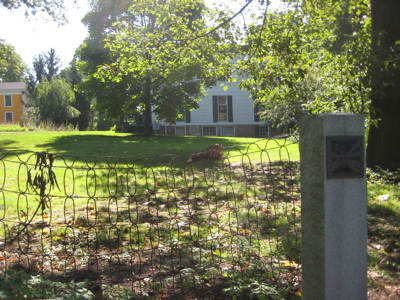
Sure my picture stinks, but at least you know it’s my picture. Note: The stone post in the foreground stands at most of the sites here in Farmington.
…………………………………………………….
2. Norton/Barney House aka Glenbrook
11 Mountain Spring Road, Farmington, CT
***Updated 2/11/2010 Below
Built in 1839 by John Treadwell Norton, who became a major supporter of the Amistad Africans. John Treadwell Norton, a prosperous businessman and “gentleman farmer” who had the Georgian-style mansion built for him, may also have been a stationmaster on the Underground Railroad. Norton, an internationally known abolitionist, was one of the founders of the Farmington Anti-Slavery Society in 1836.
It is currently used as a conference center and bed and breakfast by the University of Connecticut.
2/11/10 I received an email today with some important updated information:
Message: I am the owner of 11 Mountain Spring Rd Farmington and need
to give you the current information on our home. It was built by John
Treadwell Norton in 1832, not 1839. My husband Tim & myself bought the
house from UCONN in 2001. It is no longer called the Barney House. I
have gone back to the original name “Glenbrook”. We have done an
extensive restoration/renovation of the house and live there with our
family plus 4 dogs. Please do not pull in the drive unexpectedly
because you may injure one of our pups… Thank you, Portia
Cool lady. So yeah, this is a private home now, so admire it from Mountain Road only.
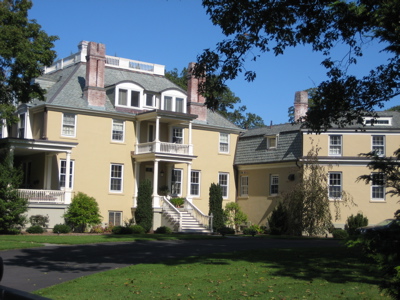
There is nothing at all to suggest this is owned by UConn. I almost ran over two small dogs while driving around the half-circle driveway to take my picture. (Oops – 2/11/10)
…………………………………………………….
3. Canal House and Pitkin Basin
128 Garden Street, Farmington, CT
The Mendi often traveled on the Farmington Canal to make appearances throughout the region to raise money for their voyage back to Sierra Leone. In this spot, one of the Amistad Africans, Foone, lost his life – apparently a suicide – while swimming in the Pitkin Basin in front of the Canal House. A shallow turnaround and storage area for boats, the Basin was also the village swimming hole.
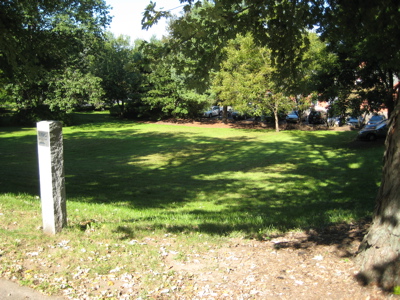
It’s now a paved parking lot.
…………………………………………………….
4. First Church of Christ Congregational
75 Main Street, Farmington, CT
One of the oldest churches in Northern Connecticut, the structure is a National Historic Landmark. Church members were active supporters of the Amistad Africans, providing them with housing, clothing and education while they lived in Farmington. Their minister, Reverend Noah Porter, supported the abolitionist cause. Upon their arrival in town, the newly-freed Mendi were introduced in the church. They attended weekly services here. Just prior to their return to Africa, their leader, Sengbe Pieh, delivered a moving address in his native language.
Later, church members supported efforts by the Rev. JC Pennington, a freed slave who became a minister, to educate Hartford’s African Americans. Pennington preached here on occasion, exchanging pulpits with Porter.
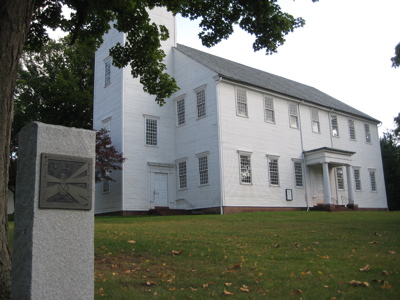
It’s a very New Englandy church, right in the heart of bucolic Main Street Farmington.
…………………………………………………….
5. Reverend Noah Porter House
116 Main Street, Farmington, CT (Private residence)
Minister of the First Church of Christ from 1806 to 1866, Reverend Noah Porter was a strong believer in abolition and education. He held to his convictions and sermonized about them from his pulpit despite opposition from vocal anti-abolitionist factions in his church.
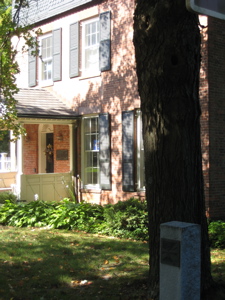 Several of the Porter’s seven children devoted their lives to education, as well. Their oldest daughter, Sarah, founded Miss Porter’s School in 1843 and their son, Noah, became president of Yale College. Oh, and Miss Porter’s boarding school today costs almost $42,000 a year to attend. The Mendi would be… I don’t know. I don’t think they could compute that.
Several of the Porter’s seven children devoted their lives to education, as well. Their oldest daughter, Sarah, founded Miss Porter’s School in 1843 and their son, Noah, became president of Yale College. Oh, and Miss Porter’s boarding school today costs almost $42,000 a year to attend. The Mendi would be… I don’t know. I don’t think they could compute that.
The American Board of Foreign Missions was founded here in 1810. The first missionaries would be sent overseas in 1812. In 1841, Margru, one of the three girls who survived from the Amistad, lived in the Porter House for eight months. Sarah Porter continued to live in the house after her father’s death in 1866, adding the third floor in the 1880s.
My picture here is abysmal, but I felt sort of creepy taking these pictures of private homes. CTMQ friend Historic Buildings of CT has a much better shot.
…………………………………………………….
6. Riverside Cemetery
Garden Street, Farmington, CT
Historic cemetery with many 18th and 19th century graves. Of particular interest are the Indian obelisk – monument, and the grave of Foone, one of the Amistad Africans. He died during their trial and stay in Farmington. The cemetery sits along the historic Farmington Canal. Off in the near distance, the fertile fields that were once worked by the Amistad former slaves can be seen.
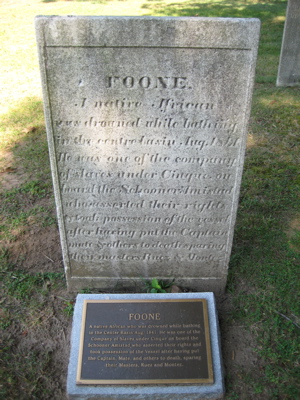
“A native African was drowned while bathing
in the centre basin Aug. 1841. He was one of the Company of Slaves
under Cinque on board the Schooner Amistad who asserted their
rights & took possession of the vessel after having put the Captain,
Mate, and others to death, sparing their Masters Ruez & Montez.”
This small cemetery is no joke. There are all sorts of abolitionists buried here, like Francis Gillette from Bloomfield (His house is part of the Freedom Trail), John Treadwell Norton, Noah and Sarah Porter, and Horace Cowles. Wilmarth Lewis, whose collections are now at the Lewis-Walpole Library (CTMQ Visit here), is also buried here. The monument to the wiped-out Tunxis reads, “”Chieftains of a vanished race, In your ancient burial place,By your father’s ashes blest, Now in peace securely rest.”
I thought that to be pretty cool.
For more on this cemetery, visit this page of the ridiculously good Farmington Historical Society site.
…………………………………………………….
7. Samuel Deming Store
2 Mill Lane, Farmington, CT
Merchant Samuel Deming traded goods from all over the world here. This site was the first place the Amistad Africans stayed when they arrived in Farmington. Later on it became their school where they attended classes five hours a day. The property is currently under private ownership and now open as “Your Village Store.”
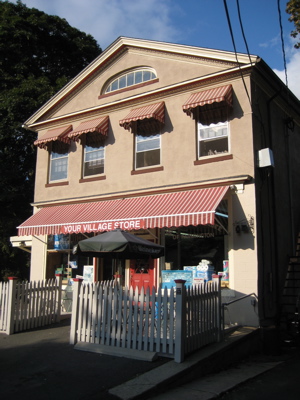
I bought some sunflower seeds here, but more importantly, picked up a couple helpful Amistad Trail and Freedom Trail brochures.
…………………………………………………….
8. Union Hall
Church Street, Farmington, CT
Now the Farmington Art Guild, this building was once the site of frequent meetings of both abolitionists and anti-abolitionists. Now the Art Guild, its upper floor was rented to both groups back in the day. It’s now owned by the very similar looking First Church of Christ above.
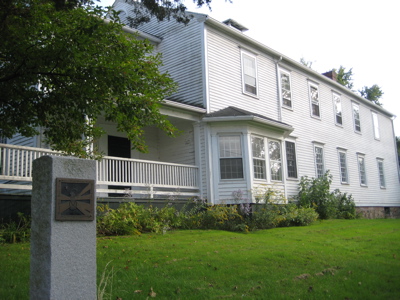
Some kids across the street heckled me for taking this picture for some reason.
…………………………………………………….
9. Farmington Historical Society
138 Main Street, Farmington, CT
Here’s the funny thing – this isn’t a museum. You can’t just go visit the charming little building on Main Street and poke around. But, in a sort of ironic way, these are the folks most responsible for putting most of the Farmington/Amistad information together in neat little brochures – the brochures that go me started on this crazy Amistad/Freedom Trail thing.
So I’m happy they’ve been added to the Trail in early 2011. They deserve to be, that’s for sure… As I think they are the only entity that offers actual guided tours of any Amistad/Freedom Trail sites. I haven’t taked a tour, but I’ve spent some time in their parking lot figuring out addresses in historic Farmington. That counts.
So here’s a big Thank You to the FHS. (Picture from the CT Freedom Trail site.)
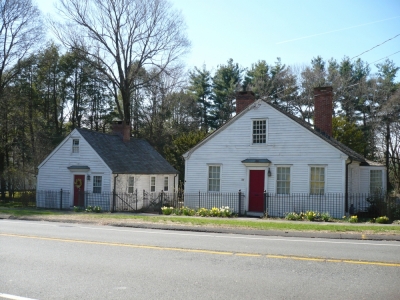






I am from Sierra Leone and lived with my family in Manchester, CT and work in Hartford. I would like my family and I to be part of this great history. My wife and I work for the Hartford Public library and would like to let the Amistad connection in Connecticut be a yearly celebration in the library. This is a great part of history and should be pass on to generations with us being part of such great history.
Comment #1 on 12.15.09 at 1:03 amThanks,
Cecil O Williams
Dear Mr.Williams amd family,
Comment #2 on 06.18.10 at 8:16 amI concur, what a great segment of world history, as well as American history. I was referred to the New Haven link through the current Captain of the Amistad replica this past Memorial day.He was extremely congenial as are all the Amistad staff I have been fortunate enough to meet. Should you ever need performers to portray the Amistad, please call me, I do Margru and can bring in drummers and dancers as well if you like. “If you want to see it, you’ve got to be it!”(Me to son while explaining why I had to sing the blues at a Beale Street tourist trap.)845-401-4103
For reference please contact Mr.Nate Vereen, Student Life-HBCU, Claflin University.
I lived in Farmington, Ct. from 1958 until 1985, (27 years).
Comment #3 on 07.22.13 at 6:06 amI miss it there, but where I lived, is built up with businesses, now.
Our family lived on Farmington Ave (rt.4), one mile west of Farmington center.
Interesting information here.
Thank you.
Ron.
What a wonderful web site this is! On Sunday, April 27, 2014 at 2:00 pm a performance will be held at the First Church of Christ Congregational, 75 Main Street, Farmington, Connecticut. The performance is a dramatic reading of Julius Lester’s award winning book, Day of Tears. It is the story, told from each character’s point of view, of a time in Savannah, GA when, over a period of three days, over four hundred people were sold. It was the largest slave auction in the history of our country.
Comment #4 on 04.03.14 at 8:32 pmI am writing a brief history to the story and believe it would be especially interesting for members of the audience to be aware of the Town of Farmington’s Freedom Trail that marks their stay there of those men and women involved in the Amistad trial.
I would like permission to use the information and possibly some of the photographs from the Connecticut Museum Quest’s website, copyrighted in 2006. It would be a wonderful addition to our brochure. Imagine the delight of the audience when they arrive at the First Church to watch a performance about the lives of slaves and their owners, only to find in addition, that they are in a town that has connections to slavery as well. I believe information on Farmington’s Freedom Trail would encourage our audience members to tour the sites, bringing history to life, as we are attempting to do in our presentation of Day of Tears.
If you can help me in any way, or have comments or suggestions that I may include in my piece, I would greatly appreciate hearing from you.
Further, is there a way for me to apply for permission to use your printed information in our brochure? I would be most grateful to hear your thoughts on this matter. Sincerely, Abby Brooks
My husband is a descendent of the Reverend Noah Porter and we visited these sites several years ago. It was especially moving to visit the church where he preached and where he invited Reverend Pennington to preach as well. It was a wonderful experience and this summer I’m coming to visit Farmington with our granddaughters.
Noah’s most famous children were Samuel and Sarah–and son Noah– but another son, Giles, also a minister, moved from New England to Garnavillo, Iowa. His son Samuel, a lawyer, moved to Minnesota and that’s where my husband, John Porter Flaten, and our family now reside. Samuel Porter’s daughter Florence was my husband’s grandmother. In the Porter tradition, Florence was an educated woman, attending Carleton College in Northfield, Minnesota.
Several years ago our granddaughter, Emma, gave a report to her first grade class about the Underground Railroad and our family connection to its history. To go with her report, she made a posture with photos from the Freedom Trail in Farmington.
Thought you might find this obituary do the Reverend Giles Porter interesting
Comment #5 on 07.03.14 at 6:14 pmhttp://iagenweb.org/boards/clayton/obituaries/index.cgi?rev=274654%3E